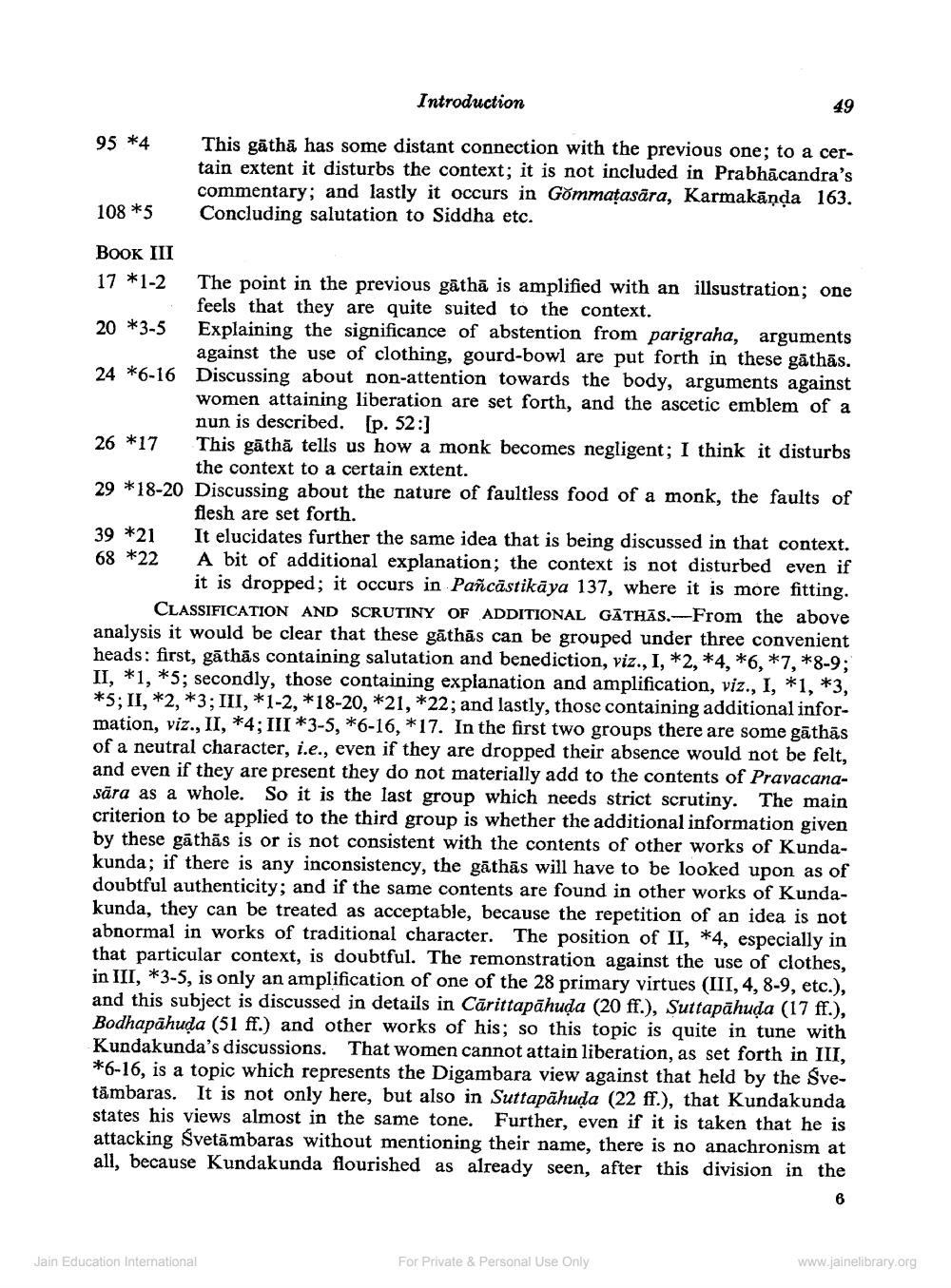________________
95 *4
108*5
Book III
17 1-2
Introduction
39 *21 68 *22
This gatha has some distant connection with the previous one; to a certain extent it disturbs the context; it is not included in Prabhācandra's commentary; and lastly it occurs in Gömmațasära, Karmakanda 163. Concluding salutation to Siddha etc.
The point in the previous gatha is amplified with an illustration; one feels that they are quite suited to the context.
20 *3-5
Explaining the significance of abstention from parigraha, arguments against the use of clothing, gourd-bowl are put forth in these gathās. 24 6-16 Discussing about non-attention towards the body, arguments against
women attaining liberation are set forth, and the ascetic emblem of a nun is described. [p. 52:]
26 17
This gatha tells us how a monk becomes negligent; I think it disturbs the context to a certain extent.
29 *18-20 Discussing about the nature of faultless food of a monk, the faults of
flesh are set forth.
49
It elucidates further the same idea that is being discussed in that context. A bit of additional explanation; the context is not disturbed even if it is dropped; it occurs in Pañcästikäya 137, where it is more fitting. CLASSIFICATION AND SCRUTINY OF ADDITIONAL GATHAS.-From the above analysis it would be clear that these gathãs can be grouped under three convenient heads: first, gāthās containing salutation and benediction, viz., I, *2, 4, 6, *7, *8-9; II, 1, 5; secondly, those containing explanation and amplification, viz., I, *1, *3, *5; II, 2, *3; III, *1-2, *18-20, *21, *22; and lastly, those containing additional information, viz., II, *4; III *3-5, *6-16, *17. In the first two groups there are some gathās of a neutral character, i.e., even if they are dropped their absence would not be felt, and even if they are present they do not materially add to the contents of Pravacanasära as a whole. So it is the last group which needs strict scrutiny. The main criterion to be applied to the third group is whether the additional information given by these gathas is or is not consistent with the contents of other works of Kundakunda; if there is any inconsistency, the gathās will have to be looked upon as of doubtful authenticity; and if the same contents are found in other works of Kundakunda, they can be treated as acceptable, because the repetition of an idea is not abnormal in works of traditional character. The position of II, *4, especially in that particular context, is doubtful. The remonstration against the use of clothes, in III, 3-5, is only an amplification of one of the 28 primary virtues (III, 4, 8-9, etc.), and this subject is discussed in details in Cärittapähuda (20 ff.), Suttapähuda (17 ff.), Bodhapahula (51 ff.) and other works of his; so this topic is quite in tune with Kundakunda's discussions. That women cannot attain liberation, as set forth in III, *6-16, is a topic which represents the Digambara view against that held by the Svetämbaras. It is not only here, but also in Suttapähuda (22 ff.), that Kundakunda states his views almost in the same tone. Further, even if it is taken that he is attacking Svetämbaras without mentioning their name, there is no anachronism at all, because Kundakunda flourished as already seen, after this division in the
6
Jain Education International
For Private & Personal Use Only
www.jainelibrary.org




